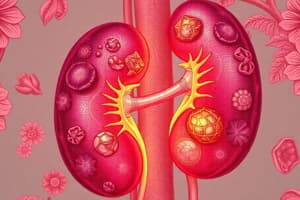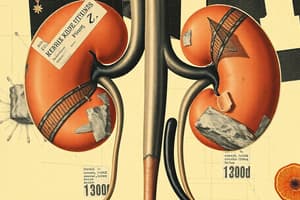Podcast
Questions and Answers
What type of renal stone is most commonly associated with infections and alkaline urine?
What type of renal stone is most commonly associated with infections and alkaline urine?
- Cysteine
- Struvite (correct)
- Calcium oxalate
- Uric acid
Which imaging technique is most useful for detecting ureteric stones?
Which imaging technique is most useful for detecting ureteric stones?
- Plain X-ray
- Non-contrast CT (correct)
- MRI
- Ultrasound
What is the primary composition of most renal stones?
What is the primary composition of most renal stones?
- Urate
- Phosphate
- Calcium and cystine (correct)
- Cholesterol
In which condition are gallstones least likely to be symptomatic?
In which condition are gallstones least likely to be symptomatic?
Which of the following types of renal stones is not visible on X-ray?
Which of the following types of renal stones is not visible on X-ray?
What is a common cause of pigment gallstones?
What is a common cause of pigment gallstones?
What type of morphology do staghorn stones exhibit?
What type of morphology do staghorn stones exhibit?
For patients with renal stones smaller than 5mm, what is the recommended management?
For patients with renal stones smaller than 5mm, what is the recommended management?
Flashcards are hidden until you start studying
Study Notes
Renal Stones
- Most common type of renal stone is calcium oxalate (60% of cases)
- Struvite stones form in alkaline urine, often due to infections like Proteus
- Uric acid stones are not visible on X-ray
- Cysteine stones form in acidic urine
- Irregular, bipyramidal or biconcave stones can be painful due to sharp projections
- Staghorn stones are large and branching, filling the renal pelvis
- Rectangular prism, teardrop, flat square, or hexagonal shapes are also observed in renal stones
- Radiopaque stones consist mainly of calcium or cystine
- Radiolucent stones are less common and may consist of orotic acid, xanthine, or matrix/drug
- Ileal resection, IBD, hypercalciuria, and hyperoxaluria increase the risk of renal stones
- Chronic pancreatitis or cholangiocarcinoma also increase the risk
- Plain X-ray KUB effectively detects radiopaque stones
- Non-contrast CT is used for suspected ureteric stones
- Ultrasound is used in children and when suspected renal tract calculi
Gall Stones
- Cholesterol stones are the most common type and linked to cholesterol metabolism disorders
- Pigment stones are often multiple, mulberry-shaped, or multi-faceted
- Mixed stones combine features of pigment and cholesterol
- Irregular, bipyramidal stones can be painful if they form staghorn calculi
- Gallstones can be solitary or multiple with various shapes including irregular, rounded, and faceted
- Gall stones are primarily radiolucent except when calcium-containing
- Bile salt imbalance, impaired enterohepatic circulation, chronic cholecystitis, infection, chronic cholangitis, IBD, and ileal resection increase the risk of gallstones
- Plain X-ray and ultrasound are used to diagnose gallstones
- Conservative management is suggested for small or asymptomatic stones
- Surgical intervention is considered for larger stones, symptoms, or increased complication risk
High Yield Points
- Gallstones are very common, but most cases are asymptomatic.
- Patients with sickle cell disease have a higher risk of developing gallstones.
- Most renal calculi are radiopaque.
- Radiolucent calculi require more advanced imaging techniques.
- Different types of renal and gallstones have unique risk factors.
- Understanding the symptoms, complications, and treatment options for various types of stones is crucial.
Studying That Suits You
Use AI to generate personalized quizzes and flashcards to suit your learning preferences.



